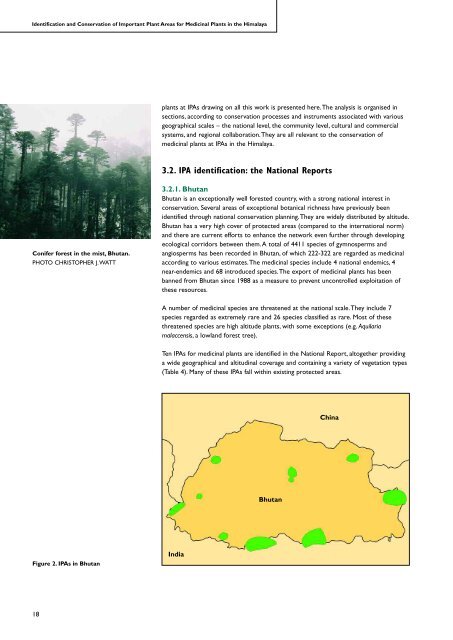Identification and Conservation of Important Plant Areas - Plantlife
Identification and Conservation of Important Plant Areas - Plantlife
Identification and Conservation of Important Plant Areas - Plantlife
- No tags were found...
You also want an ePaper? Increase the reach of your titles
YUMPU automatically turns print PDFs into web optimized ePapers that Google loves.
<strong>Identification</strong> <strong>and</strong> <strong>Conservation</strong> <strong>of</strong> <strong>Important</strong> <strong>Plant</strong> <strong>Areas</strong> for Medicinal <strong>Plant</strong>s in the Himalayaplants at IPAs drawing on all this work is presented here.The analysis is organised insections, according to conservation processes <strong>and</strong> instruments associated with variousgeographical scales – the national level, the community level, cultural <strong>and</strong> commercialsystems, <strong>and</strong> regional collaboration.They are all relevant to the conservation <strong>of</strong>medicinal plants at IPAs in the Himalaya.3.2. IPA identification: the National ReportsConifer forest in the mist, Bhutan.PHOTO CHRISTOPHER J.WATT3.2.1. BhutanBhutan is an exceptionally well forested country, with a strong national interest inconservation. Several areas <strong>of</strong> exceptional botanical richness have previously beenidentified through national conservation planning.They are widely distributed by altitude.Bhutan has a very high cover <strong>of</strong> protected areas (compared to the international norm)<strong>and</strong> there are current efforts to enhance the network even further through developingecological corridors between them.A total <strong>of</strong> 4411 species <strong>of</strong> gymnosperms <strong>and</strong>angiosperms has been recorded in Bhutan, <strong>of</strong> which 222-322 are regarded as medicinalaccording to various estimates.The medicinal species include 4 national endemics, 4near-endemics <strong>and</strong> 68 introduced species.The export <strong>of</strong> medicinal plants has beenbanned from Bhutan since 1988 as a measure to prevent uncontrolled exploitation <strong>of</strong>these resources.A number <strong>of</strong> medicinal species are threatened at the national scale.They include 7species regarded as extremely rare <strong>and</strong> 26 species classified as rare. Most <strong>of</strong> thesethreatened species are high altitude plants, with some exceptions (e.g. Aquilariamalaccensis, a lowl<strong>and</strong> forest tree).Ten IPAs for medicinal plants are identified in the National Report, altogether providinga wide geographical <strong>and</strong> altitudinal coverage <strong>and</strong> containing a variety <strong>of</strong> vegetation types(Table 4). Many <strong>of</strong> these IPAs fall within existing protected areas.ChinaBhutanFigure 2. IPAs in BhutanIndia18
















